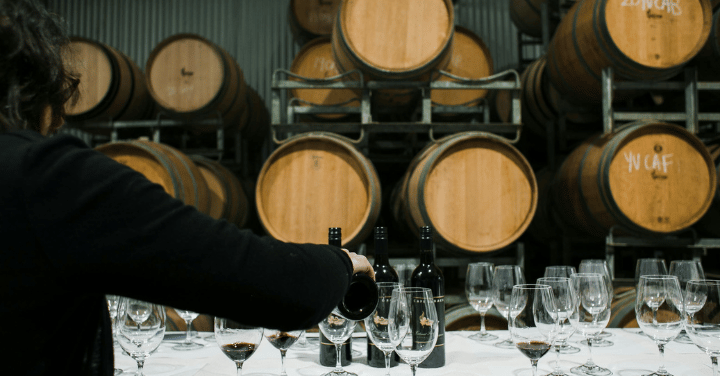How many different types of beer are there?
If we are counting all the styles, substyles, and hybrid styles of beer, there are more than one hundred different types of beer in the world. Especially with the rise of the craft beer scene and over 9,000 craft breweries only in the United States, even as a beer expert, you can get easily confused with all the different beer types and their flavors.
It gets less scary when you know that there are two main types of beer, and all the others fall under their substyles.
What are the two main types of beer?
We can classify all the beers into two main types of beer: Lager and Ale.
Once you understand the two main beer types and the way they’re fermented and what their main ingredients are, you’ll know what to expect out of their substyles in terms of taste and flavors and you’ll know how to easily tell the difference between different types of beers.
Before we dive in, we’d like you to familiarize yourself with the verbiage that will commonly be used in this post just like in any other on this beer blog and many others. It’s some basic beer terminology that you need to know at the very beginning.
What is ABV?
ABV is an acronym that stands for Alcohol By Volume. That is a metric that is used to determine the content of Alcohol in an alcoholic beverage. ABV is an important metric in beers just like in any other alcoholic beverage.
It impacts the flavor of the beer tremendously, especially if it’s not well implemented and if the beer is not served at the right temperature – that’s when you’ll feel it the most. When alcohol content is too high, you’ll probably feel that unpleasant warming feeling when exhaling on your nose after a big sip of a beer, or other alcoholic beverage that is noticeably high in ABV.
When the brewer is experienced, ABV is used to achieve the perfect balance between bitterness and sweetness.
What is IBU?
IBU is another acronym commonly used in the beer world; it stands for International Bitterness Unit and it is used to gauge the bitterness level of a beer. The IBU scale can range from 0 to more than 120, though the human’s sense of taste is unable to detect any more bitterness.
Though the unit is international and very commonly used, it can be pretty ambiguous. While the numbers are clear, our perception of bitterness can make us question the numbers. The reason why is that when it comes to beer, it’s all about balance.
It happens quite often that the numbers don’t quite match our perception of bitterness and that you see a high number of IBU on the beer that doesn’t actually taste bitter as maltiness and sweetness balance out the bitterness in beer.There are examples where the number of IBU is not that high, but the beer tastes bitter just like it can be the case with some German Pilsners that can have a low IBU, but taste quite bitter because of the crisp malt character.
What are two types of beer fermentation?
The process of fermentation is probably well known by now. Simply put – it’s the chemical conversion of sugars to ethyl alcohol, releasing carbon dioxide and heat as a by-product. If there wasn’t fermentation – the beer wouldn’t have the alcohol content and the much-appreciated bubbles.
There are two types of beer brewing fermentations that are (among other factors) deciding the style of beer: Top Fermentation – producing ales (usually fermenting on warmer temperatures), and Bottom Fermentation – producing Lagers (usually fermenting on cooler temperatures).
What are the 2 main types of beer?
Any beer that you’ve ever tasted can be broken down into basic types of beer. The beer is either ale or lager. The main differences between these two types of beer are in the yeast that is used for fermentation processes and the temperature.
Well, that might sound super small and simple now, but depending on the yeast type and the fermentation process, the taste can be completely different.
Different types of beer
Ale
Ales are brewed with Saccharomyces cerevisiae yeast. This yeast ferments throughout the beer and settles at the top of the vessel and this makes the primary difference between ales and lagers.
Ales are fermented at warmer temperatures, usually between 60 to 72 F (15 to 22 C).
Ales are also the oldest type of beer. The lagers were introduced in the 16th century. Before that all the beers were ales. They tend to be flavorful, robust, and complex. Ales are also fruitier, more aromatic, and usually have higher IBU.
Pale Ale Type of Beer
Versions of pale ale differ. American Pale Ales tend to be honey-colored to amber, while British Ales appear more in deeper copper color. They’re usually capped with snowy white or eggshell-colored heads.
Pale ales tend to be hoppy, but they mostly rely on malt sweetness that releases flavors of biscuits and toffee.
Unlike IPAs, the hops are rather used to scent and flavor the beer than to add bitterness.
Tasting pale ale, you’ll probably note citrus pine or flowers with not too harsh bitterness. With its effervescence, it’s probably one of the very few types of beer that can combat the acid of tomato paste and vinaigrette but also complement fresh fish and semi soft cheeses.
Pale Ale Statistics
ABV Range: 4.5 – 6%
Bitterness: 25 – 50 IBU
Serving Temperature 50 – 60 F (10 – 16C)
Glass: English Pint Glass
India Pale Ale Type of Beer (IPA)
Despite the name, IPA was never brewed in India nor was it mass consumed by Indians. The idea of the British, who actually brewed it, was originally to create a strong, hoppy, elegant beer that would survive the long-distance travels of those who managed affairs in the colonies.Now, IPA is one of the most popular craft beer styles and is nearly synonymous with craft brewing.
IPA Statistics
ABV Range: 5 – 7%
Bitterness: 40 – 75 IBU
Serving Temperature 50 – 60 F (10 – 16C)
Glass: IPA Glass
American IPAs
Generous amounts of hops added throughout the brewing process of American Pale ale lead to the evident notes of citrus, pine, or flowers depending on the hops variety. Fruit notes like grapefruit, tangerine, or apricot are evident, too.
Twenty years ago, inspired by the original IPAs journey, brewers were occasionally adding oak chips to fermenters to extract tannins. Some breweries are still aging their brews in oak casks adding tannins and vanilla to the palate.
American IPA is not too malty or high in alcohol, and not too heavy either. They have invigorating, bright hoppy flavors that for some beer drinkers started to define craft beer.
British IPAs
Unlike American IPas that focus on hop intensity, typical British IPAs will have the more pronounced malty character of caramel and toffee or biscuit and toast with darker hues of amber. Due to the different variety of hops used, earthiness and spiciness can prevail.
Bitter Ale
I was once taught that bitters, out of all the beer styles, might be the most harmoniously balanced. They’re brewed with equal parts of malt, hop, and yeast, never favoring one over the other. Bitters are designed to be drunk in sessions of twos and threes.
The strongest bitters are forceful and bold but don’t sacrifice malt flavors for the hop intensity, instead, they show elegant, soft, caramelly, or bready malty character, but hops are not neglected either. In Britain, where the best bitters come from, brewers treat them like their artistic expressions. Bitters make a great companion to fish and creamy soups.
Bitter Ale Statistics
ABV range: 3.5–4%
bitterness: 20–45 IBU
Best or special
ABV range: 4–6%;
bitterness 20– 45 IBU
Serving temperature: 50°–60°F (10 – 16C)
Glass: Pint glass
Mild Ales
Mild Ales are native to Britain, where “mild” refers to gentle, moderate, and unaggressive. Mild Ales are usually about 3% in ABV or just shy, more because the goal is to emphasize the flavors, not the strengths of a beer. Therefore, they’re not brewed or drunk with the intoxication in mind.
There are some pale mild ales, but they’re mostly dark, ruddy to mahogany. They’re usually brewed sweet, and full-bodied with a creamy texture in order to compensate for the low alcohol content.
They’re usually paired with beef dishes and Britain’s pub favorite – fish and chips.Mild Ales are pretty rare in the US, but the US adopted another similar concept from Britain – session beer.
Mild Ale Statistics
ABV range: 3–4%
Bitterness: 12–25 IBU
Serving temperature: 50°–60°F (10 – 16C)
Glass: Pint glass
Porter and Stout
Porter originates from London, England, where it was developed in the 18th century. Though it was first brewed in Ireland, by Arthur Guinness, the founder of Guinness Brewery It got its name from the porters (people who carry objects or cargo for others) that made it popular.
Typically dark-bodied, due to brown malt, porters are very well-hopped beers.
Though, porters have a more or less common history with another dark-bodied type of beer: stout. The name stout, which referred to dark beer in general, came about because the strong porters were advertised as “stout porters”, now just short “stout”.
Statistics
Porter
ABV range: 4–6%;
bitterness: 20–50 IBU
Baltic Porter
ABV range: 7–10%;
bitterness: 20–40 IBU
Irish stout
ABV range: dry 4–5%,
export 5.5–8%;
bitterness: dry 20–40 IBU
export 30–60 IBU
Sweet and milk stout
ABV range: 4.5–6%;
Bitterness: 15–40 IBU
Imperial stout
ABV range: 8–14%;
bitterness: 50-100 IBU
Serving temperature: 50°–60°F
Glass: Pint glass, tulip snifter for an imperial stout
Some other types of Ales are:
- Brown Ales
- American Ales
- American Strong Ales: Double or Triple IPAs
- Kölsch and AltbierBelgian Ales
But Brewers Association defines many more Ale Styles and groups them by:
- British Origin AleStyles
- North American Origin AleStyles
- Belgian and French Origin AleStyles
- Irish Origin AleStyles
- German Origin AleStyles
- Other Origin AleStyles
Lagers
By definition, a Lager type of beer is brewed with yeast that enjoys cooler temperatures and tends to sink rather than rise. Besides the special lager yeast type (Saccharomyces pastorianus), this type of beer is known for its demand for conditioning after primary fermentation, that’s why it’s called lager after all. The German word “lager” means “storing”.
This difference in the styles, the lagers, and ales, is mostly only on paper. While some lagers and ales are traditionally made, there are ales that are “lagered” which means that they are brewed with ale’s yeast, but put down for conditioning for a certain period of time.
A typical example of the beers not knowing of styles anymore is French bieres de garde which are called ales but are conditioned after fermentation for weeks or months. Sometimes, they’re even brewed with the lager yeasts.
Generally speaking, lagers are more about the taste than the yeast and fermentation. Though one is due to the other. But the point is that the lager yeasts, the yeasts that demand cooler temperatures result in a beer that is not that rich in taste like ales. Lagers tend to be polished, clean, crisp, and refined beers.
Pilsner
Pilsner might be the most famous of all larger styles. It’s an effervescent, golden in color, crisp and elegant type of beer. It was first made in the Czech city of Pilsen, and it had flavors of bread malt, and peppery hops. According to some opinions, it was the most important beer ever brewed that changed the course of brewing history.
You might find yourself torn between the original Czech pilsner, and those later made in Germany. The main difference is in the approach to hopping.
Czech Pilsner tends to be a bit deeper in color and brewed with Bohemian hops, while German pilsners are more malt orientated and tend to use more peppery hops. Both styles balance grainy malt bodies with hop spice.
Helles lagers emphasize soft maltiness. They use German aroma hops. But there’s another type of pilsner that is still in search of its identity – Dortmund Exports. They were once made to satisfy the pallets and thirst of coal and steel workers – burly, brassy, with alcohol and hops overexpressed. Nowadays, they become much lighter, and more drinkable, still developing as a style.
Whatever pilsner you choose, you’ll end up with a crisp effervescent, refreshing beer that pairs well with food. While lagers have their strengths, it’s easier to pair pilsner with fried food, spice but also pork – especially Bavarian sausages.
Pilsner Statistics
ABV range: 4.4–5.5%;
bitterness: 20–45 IBU
Helles ABV range: 4.5–5.5%;
bitterness: 15–25 IBU
Dortmund export ABV
range: 5.0–6.0%;
bitterness:25–35 IBU
Serving temperature: 38°–45°F
Glass: Pilsner glass (pilsner, export); stein (helles)
Dark Lager
“Dunkel” in Bavaria, “Schwarz” in Thuringia or “Tmavé” or “Cĕrné” in Czech Republic is a solid, dark lager. In Bavaria, they can be anywhere from amber to black, but they are recognizable for being smooth and malty with hints of roastiness.
Schwarzbier is a much rarer type of dark lager, but still dark in color with flavors ranging from cocoa and vanilla to coffee and licorice. Czech dark lager, whether dark (tmavé) or black (černé), is usually brewed around the strength of German dark lager. However, due to the malt, they tend to have a caramel flavor.
If you just think for a second about what you would pair it with, in terms of food, I’m sure that the barbecue would be your first choice. This type of beer comes from meat-loving countries after all and pairs well with roasts but works deliciously with American barbecue, too.
Dark Lager Statistics
Dunkel
ABV range: 4.7–5.5%;
bitterness: 15–25 IBU
Schwarzbier
ABV range: 4.7–5.2%;
bitterness: 20–30IBU
Tmavé/černé
ABV range: 4.0–5.5%;
bitterness: 15–35 IBU
Serving temperature: 45°–50°F
Glass: Mug or pint glass
Amber Lagers – Marzen – Oktoberfest
Amber lagers – the most famous harvest festival beers, a beer of celebration, the color of autumn leaves. They may look more golden or reddish than amber in color, but the point is in strength, not the color anyways.
Oktoberfest is rich and round with hints of caramel flavor and a hint of toast. Some say that the amber lagers are the best-suited beers for food and that they work perfectly well with roasted chicken that is traditionally served at the Bavarian fest.
Amber Lager (Oktoberfest or Marzen) Statistics
ABV range: 4.5–6%
Märzen ABV range: 5–6.5%;
bitterness: 18–30 IBU
Vienna lager
ABV range: 4.5–5.5%;
bitterness: 15–30 IBU
Serving temperature: 38°–45°F
Glass: Stein
Bock Beer
Explaining Bock and its substyles would need a lot of time, so in this post, we’ll keep it as basic as possible.
Bock type of beer is native to Germany. Not only that they’re strong, but also refined and elegant with pronounced maltiness and luxurious warmth that comes from high alcohol content, but nicely fitted into a perfect sip.
Bock is a strong old-school beer. Some substyles of bock, like darker doppelbocks and eisbocks, are among the strongest beers in the world.Like most German beers, Bocks are also malt centered and like Marzens (Amber Ales) often made for special occasions.
You can probably recall some of the old beer etiquette images that had an old-fashioned wooden barrel and goat on them. That doesn’t make any sense to be on the beer, but yeah, that’s bock.
There are many more different lager substyles. Brewers Association groups them into three groups, and those are:
- European Origin Lager Styles
- North American Origin Lager Styles and
- Other Origin Lager Styles
You can find all lager substyles listed in Brewers Association Style Guidelines.
Is wheat beer Lager or ale?
Generally speaking, wheat beer is an Ale. It’s the top fermented beer, but their name can vary depending on where they are made, so you can encounter: Weißbier, Witbier, Bière Blanche, and other names all for the same type of beer. Besides the name, recipes can vary, too.
For brewing wheat beer, at least 50% of wheat is added to barley malt, but for brewing some variations like Witbier, brewers can use flavorings like coriander or orange peel, and Belgian wheat beers are made with raw unmalted wheat very often.
The two most common wheat beers you might encounter are: Weizenbier and Witbier.
Weizenbier
German wheat beer is native to Bavaria and it’s usually called Weißbier, which literally means white beer that refers to air-dried malt. For making Weißbier in Bavaria, wheat replaces a significant amount of malted barley.
For making Weizenbier in Germany, top-fermenting yeast must be used by law. Weizenbier can be found also as Hefeweizen (unfiltered or hazy) or Kristallweizen (crystal white, where yeast and wheat proteins are filtered).
Witbier
Mainly brewed in Belgium and Netherlands, this top-fermented beer, next to hops, can very often contain coriander, orange or bitter orange.
Some other varieties of wheat beer are:
- Gose
- Lambic
- Berliner Weiße and
- Grodziskie
Even some ancient beers contained wheat: “The First Beer Styles From the very start, beer was made in different styles. One especially detailed list from Sumerlists beer by age, color, quality, and recipe. One type of beer had lots of spelt and no wheat, while another had lots of wheat and no spelt. Egyptians also had at least seventeen different beer types, including some evocative varieties like “joybringer,” “heavenly,”“beer of the protector,” and “beer of truth” (though that one was just for the gods).” (Source: Beer Bible)
Note that these are some general notes on different styles of beer and that there are indeed two main types of beer, but there are also hybrid types of beer that are a kinda mix of Lager and Ales. If you’d like to taste few beer types in one session, consider going to a local brewery for a beer flight.





